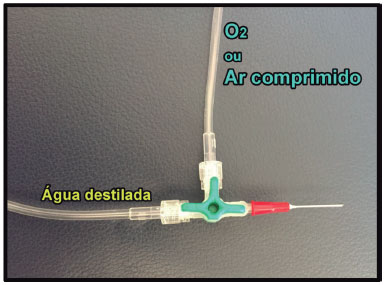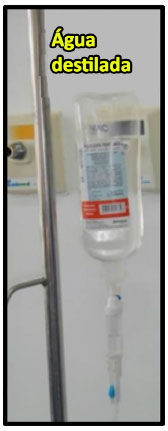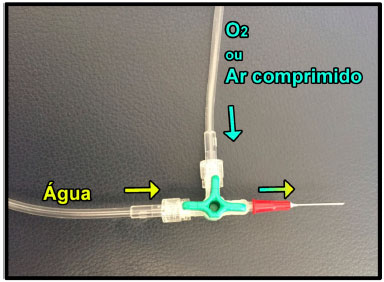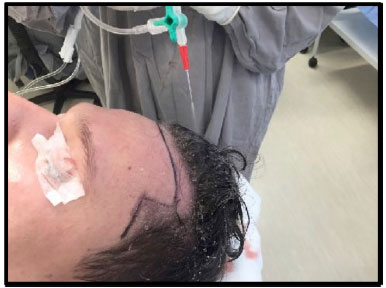

Ideas and Innovation - Year 2017 - Volume 32 -
Hair Wash: improving hair transplantation
Hair Wash: otimizando o transplante capilar
ABSTRACT
An efficient use of operative time is a concern regarding not only hair transplantation but all surgical procedures. In case of large areas to be transplanted, no more than 6 hours per session is recommended, to avoid damaging transplanted hairs. We developed a device using sterilized materials, with the exception of a compressed air flowmeter, support serum, and compressed air, which remain outside the surgical field. The "Hair Wash" device shortened the operative time and improved the surgery. The "Hair Wash" device is feasible and easily replicable, and improves the hair transplant procedure.
Keywords: Transplant; Quality improvement; Alopecia; Hair.
RESUMO
O uso eficiente do tempo cirúrgico é uma preocupação que envolve não apenas o transplante capilar, mas cirurgias como um todo. Preconiza-se que a cirurgia da calvície, principalmente no tocante às grandes sessões de transplante de cabelos, não devam ultrapassar 6 horas por sessão, sob o risco de prejudicar os fios transplantados. A montagem do dispositivo se procede utilizando-se material estéril, com exceção do fluxômetro de ar comprimido, suporte de soro e a saída de ar comprimido que ficam fora do campo cirúrgico. O método "Hair Wash" possibilitou uma diminuição no tempo cirúrgico e otimização da cirurgia. O "Hair Wash" é um dispositivo viável, de fácil replicabilidade e que otimiza a cirurgia de restauração capilar.
Palavras-chave: Transplante; Melhoria de qualidade; Alopecia; Cabelo.
A hair transplant procedure involves complex logistics, including the availability of a specialized team and appropriate surgical equipment1,2.
In the 1990s, hair transplantation was advanced by the introduction of the binocular microscope by Dr. Robert Limmer for dissection of follicular units. Since then, numerous devices have been invented or modified in order to improve hair transplantation, either to achieve better outcomes, facilitate the technique, or to shorten the operative time. The technique of Follicular Unit Extraction (FUE), described in 2002, is another important advance in the evolution of hair transplantation3.
The efficient use of operative time is a concern regarding not only hair transplantation but all surgical procedures4, which can last from 5 to 6 hours when performed by an experienced surgical team. Depending on the technique, hair transplantation surgery can last over 10 hours, risking damage to transplanted hairs5. Therefore, reducing the operative time has always been a goal of hair transplant surgeons.
METHODS
The following material is necessary to assemble the "Hair Wash" device:
• 2 serum macrodrop sets;
• 2 extension tubing sections;
• 1 3-way stopcock;
• 1 medium micropore filter;
• 1 support serum;
• 1 liter of distilled water or 0.9% saline (preferably in rigid plastic);
• 1 compressed air flowmeter;
• 1 compressed air output;
• 1 needle with no bevel (used to instill medications).
Assembly
This device is assembled using sterilized materials, with the exception of a compressed air flowmeter, support serum, and compressed air output, which remain outside the surgical field.
The assembly of the device starts by connecting the 3-way valve to a needle with no bevel and two macrodrop sets (Figure 1). Then, the end of one set is connected to a bottle containing distilled water or 0.9% saline (Figure 2). The end of the second set must be connected to an extension hose and air flowmeter, which in turn must be connected to compressed air output (Figure 3).

Figure 1. One 3-way stopcock, one needle with no bevel, and two dropper sets.

Figure 2. A bottle containing 0.9% saline.

Figure 3. Compressed Air Output.
Use
The 3-way stopcock is used to open the system and direct the air, according to the different purposes listed below. The first step in using the device is to direct the airflow into the bottle of distilled water, in order to increase the pressure inside the bottle. A 3-way stopcock must be used to open the pathway between the compressed air supply and the bottle of distilled water (Figure 4). Care should be taken to ensure that this air is directed for only a short period of time, to prevent pressure from breaking the bottle. A compressed airflow of 2 to 3 L/min is recommended and must be controlled by the flowmeter.

Figure 4. A 3-way stopcock opens the pathway between the compressed air supply and the bottle containing distilled water.
To use the spray, the 3-way stopcock should remain open. The bottle undergoes an increase in internal pressure due to previous air injection, and will cause the ejection of distilled water towards the 3-way stopcock (Figure 5). The 3-way stopcock will then provide a gentle spray through the needle, with distilled water being forced out by compressed air (which enters through a different inlet) (Figure 6).

Figure 5. A 3-way stopcock.

Figure 6. A 3-way stopcock allowing the spray to exit smoothly through the needle.
RESULTS
The "Hair Wash" device shortened the operative time and improved the surgical procedure.
DISCUSSION
Hair transplantation requires a specialized team and appropriate equipment, in order to be successful. Given the advances in the techniques, it is necessary to reduce the operative time. A decrease in operative time provides benefits to the patient by decreasing surgical trauma and the use of anesthetics, resulting in a lower complication rate4 and reduced surgical costs, which correlates to the booking time in the operating room.
In hair transplantation, some operative times are unavoidable, but others might be shortened. Maintaining a clean intraoperative site and preventing bleeding and clot formation are time-consuming tasks. Hydration is a critical procedure to the survival of hair grafts, and also requires the time and attention of the surgeon2. There are many ways of cleaning the surgical site and maintaining the hydration of follicular units, either during preparation, conditioning, or after grafting (using sprays, syringes, gauze, and wet compresses).
The "Hair Wash" device can be used to remove the donor area in the FUE or Transplantation procedure while grafting hair follicles, in the final cleaning of the scalp, and during follicle hydration; a distilled water or saline spray does not cause major local damage, and to optimizes the use of operative time.
The "Hair Wash" device is a low-cost tool, easy to assemble, and made with disposable materials available in any hospital or surgical clinic. Easy to use, it consists of a sterilized device that allows the exit of a controlled jet. The device lessens the burden on the surgeon, and is safe and does not compromise the viability of hair grafts and the surgical outcome.
CONCLUSION
The "Hair Wash" device is feasible, easily reproducible, and improves the hair transplant procedure.
COLLABORATIONS
FBH Final approval of the manuscript; writing the manuscript or critical review of its contents.
SNS Completion of surgeries and/or experiments; writing the manuscript or critical review of its contents.
CSS Analysis and/or interpretation of data.
LFOJ Analysis and/or interpretation of data; conception and design of the study.
GSS Analysis and/or interpretation of data.
REFERENCES
1. Barrera A, Uebel CO. Transplante Capilar: A Arte do Microenxerto e Minienxerto de Unidade Folicular. São Paulo: Revinter; 2015.
2. Kim JY, Khavanin N, Rambachan A, McCarthy RJ, Mlodinow AS, De Oliveria GS Jr, et al. Surgical duration and risk of venous thromboembolism. JAMA Surg. 2015;150(2):110-7. DOI: http://dx.doi.org/10.1001/jamasurg.2014.1841
3. Rassman WR, Bernstein RM, McClellan R, Jones R, Worton E, Uyttendaele H. Follicular unit extraction: minimally invasive surgery for hair transplantation. Dermatol Surg. 2002;28(8):720-8. PMID: 12174065 DOI: http://dx.doi.org/10.1097/00042728-200208000-00014
4. Ammori BJ, Larvin M, McMahon MJ. Elective laparoscopic cholecystectomy: preoperative prediction of duration of surgery. Surg Endosc. 2001;15(3):297-300. DOI: http://dx.doi.org/10.1007/s004640000247
5. Salanitri S, Gonçalves AJ, Helene A Jr, Lopes FH. Surgical complications in hair transplantation: a series of 533 procedures. Aesthet Surg J. 2009;29(1):72-6. DOI: http://dx.doi.org/10.1016/j.asj.2008.11.005
1. Hospital da Cruz Vermelha, São Paulo, SP, Brazil
2. Santa Casa de São Paulo, São Paulo, SP, Brazil
3. Sociedade Brasileira de Cirurgia Plástica, São Paulo, SP, Brazil
4. Universidade Federal do Estado de São Paulo, São Paulo, SP, Brazil
Institution: Hospital Cruz Vermelha Brasileira, São Paulo, SP, Brazil.
Corresponding author:
Farid Bark Hamdar
Avenida Moreira Guimarães, 699 - Indianópolis
São Paulo, SP, Brazil - Zip Code 04074-031
E-mail: farid_hamdar@icloud.com
Article received: April 22, 2017.
Article accepted: July 9, 2017.
Conflicts of interest: none.


 Read in Portuguese
Read in Portuguese
 Read in English
Read in English
 PDF PT
PDF PT
 Print
Print
 Send this article by email
Send this article by email
 How to Cite
How to Cite
 Mendeley
Mendeley
 Pocket
Pocket
 Twitter
Twitter